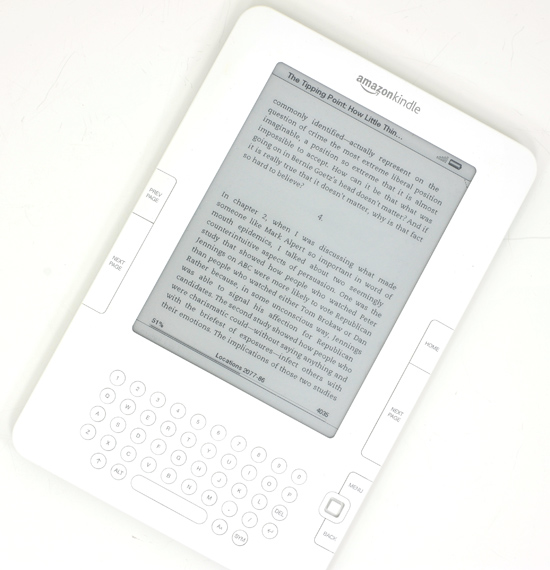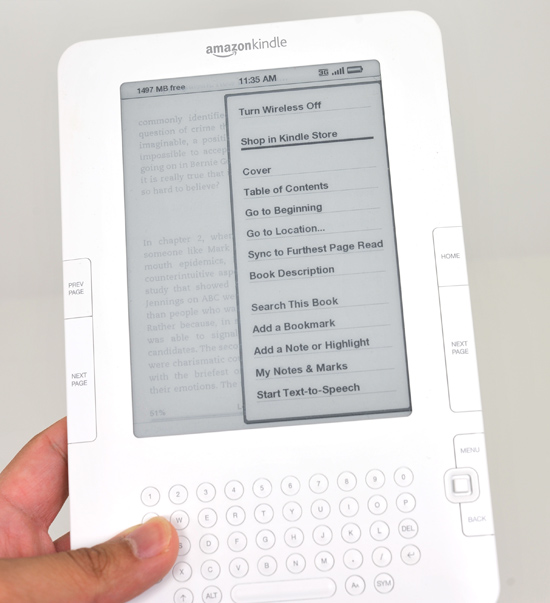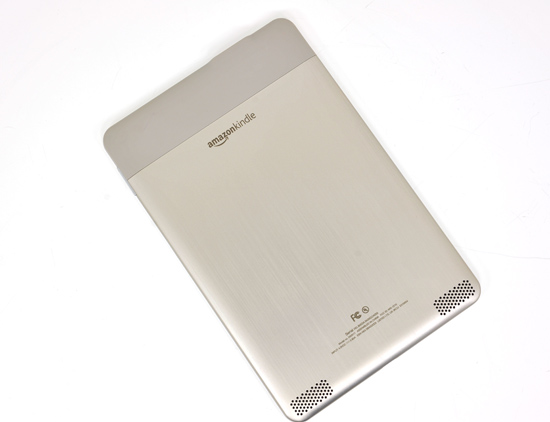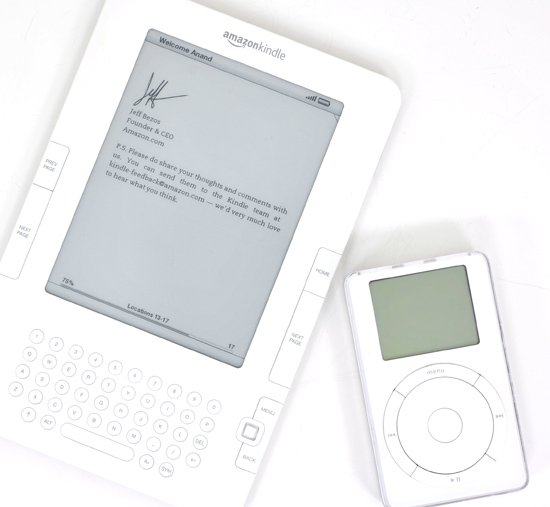Anand's Thoughts on the Kindle 2 and Marvell Making Affordable eBook Readers
by Anand Lal Shimpi on November 3, 2009 12:00 AM EST- Posted in
- Smartphones
- Mobile
2010 is supposed to be the year of many things. I’ve heard it called the year of Android and more recently, the year of the ebook reader.
I used to read a lot when I was a kid at the behest of my parents. My mom always tried to enforce a balance between video games and books. That unfortunately stopped as AnandTech took off. Most of my recreational reading turned into trying to understand datasheets or reading other reviews, the rest of the time was spent writing.
My first and only ebook reader was Amazon’s Kindle 2, and while it didn’t reinvigorate my passion for reading, it did a lot better than expected.

Amazon really got the form factor down perfect for the Kindle 2. For a rigid device, I don’t believe there’s a better formfactor than what Amazon managed with this thing. It feels comfortable in my hands and it’s thin and light enough that I don’t mind carrying it around. Give it a high res multitouch screen and I think this may be the ideal form factor for an Apple Tablet.
The Kindle 2 solves my problem of being stuck waiting somewhere with nothing to do. A couple years back I bought a few books that I wanted to start carrying with me so I had something to do if I was waiting for a meeting, appointment, ferry, whatever. A good idea, but in practice I almost never had the books with me.

The Kindle 2 lets you carry an unreasonable number of books of course, so that solves the carrying problem. You also get free wireless access, wherever you get a cellphone signal, to Amazon’s Kindle Store. The books download in a matter of seconds and the process is very simple. You can also have books wirelessly delivered (for no additional charge) to your Kindle if you purchase them on a PC.

The biggest downside about the whole book carrying/acquiring aspect is Amazon’s Kindle Store is hardly complete. While the majority of books I’ve wanted to read on the Kindle were in the store, there have been a few notable exceptions. Unfortunately there’s very little recourse. You can send a note to the publisher on Amazon’s book store indicating your interest in a Kindle version, but you’re otherwise out of luck.

Normally the caveat about displays would come next. About how it’s easier to look at and feel pages of a book than read something on an underpowered PC. While the Kindle 2 and other ebook readers lack the flexibility of paperback, they use electrophoretic displays (EPDs) which are far easier on the eyes than an LCD.
Unlike LCDs, EPDs are static until the screen contents change - there’s no refreshing. That’s great for power consumption, but not so great for moving images, in other words - perfect for a book.
EPDs also have no backlight, they work by reflecting/absorbing light - just like a piece of paper. Unfortunately this means that reading a Kindle in bed at night requires a reading lamp, yep those still exist.
The end result is a very book-like display, perfect for reading text although not great for high resolution images. There’s just one last problem: most SoCs don’t have integrated EPD controllers, they are used to displaying on LCDs.
The Kindle 2 uses a separate EPD controller made by Epson. The external (to the system’s SoC) controller requires its own DRAM and NAND flash. The DRAM is used to store what’s currently on the EPD and what’s going to appear next, the difference of the two is needed to calculate how to charge the EPD to change the display. The NAND flash is used to store information about the specific display used in the device. There’s apparently a lot of display-specific tuning that the controller needs to be aware of, something that can very from one display to the next in manufacturing or even due to environmental conditions. The EPD controller stores data about the display it’s paired with in local NAND flash.
The problem with this approach is that it unnecessarily duplicates hardware. The Kindle 2 (and all other ebook readers) already use an application processor SoC which has its own flash and DRAM. But most SoCs feature an integrated display controller for conventional video outputs, not an EPD controller. You can probably guess where I’m heading with this.
Marvell’s ARMADA 166E: With Built-in EPD Controller
A couple of weeks ago Marvell announced its ARMADA line of ARM-based SoCs, among them was the ARMADA 166E. Based on Marvell’s PJ1 ARM CPU core, the 166E is designed for applications with low performance requirements like digital photo frames and ebook readers. The 166E is also the world’s first application processor with an integrated EPD controller. Not only does the integrated EPD controller reduce board size (you integrate one more controller), but it also reduces cost: you don’t need another package with an integrated NAND flash and you don’t need another DRAM.

Marvell is also going to be offering a complete platform around the 166E. Platform, in the ebook reader sense means the 166E as well as Bluetooth, WiFi and cellular network support.
Today Marvell is announcing that it has a number of customers currently developing ebook readers based on the 166E, with the first examples due out in 2010. As companies like Marvell make putting together an ebook reader easier, you can expect hardware vendors to jump into the reader business. We’ve already heard rumors of ASUS building an ebook reader as a part of its Eee lineup.

I’m not sure how large the market will get, or even if ultimately there’s room for a standalone ebook reader as a primary device; if it weren’t for the reliance on an EPD, I’d say that eventually the functionality would just get integrated into a tablet. There’s always the Kindle app for the iPhone.

Looking back at my Kindle 2, I like it a lot. It’s definitely the iPod of the ebook world. Unfortunately for Amazon and other manufacturers getting into the ebook reader market, reading just isn’t as popular as listening to music. We probably won't see the same hype over ebook readers in 2010 that we did for MP3 players a decade ago, but it's their turn to shine.










51 Comments
View All Comments
djc208 - Wednesday, November 4, 2009 - link
I think these readers are just step one. Like MP3 players, they were fancy stand-alone devices. Now just about everything has a built in MP3 player.The e-book reader is a niche product right now because of it's price and manufacturer created limitations. Let the price move down and a more universal type format for easier storage and interaction and I think these will quickly move into the commercial space in a huge way, and then eventually to the general public.
I could see huge savings at my job for a device like these. All the paperwork that we generate and process, moved onto one of these devices, used at the worksite and returned and uploaded back into the network when complete. No torn pages, garbled signatures, or printing errors. Not to mention the savings in paper, toners, copiers, faxing, etc.
medi01 - Wednesday, November 4, 2009 - link
You are missing the point here: not everything can be integrated into something. Important features of ebooks as of now are:a) bigger than on usual pocket devices, e-ink (= slow) screen
b) battery lasts for weeks
AFAIK amazon alone has sold more than 4 millions of kindles, and number of ebook reader is still growing. That's quite a big number for a niche product.
Egowhip69 - Saturday, November 7, 2009 - link
I think you miss a very big and important point..."Let the price move down and a more universal type format for easier storage and interaction..."
IF the producers of these systems were really thinking long term, they'd sit down and specify ONE open format that works with ALL e-readers...
While, yes, the Amazon has sold 4+ mil devices... they are still engaged (albeit on a MUCH smaller scale compared to other markets) in a format war... Reality says, pick an open standard with your opponents, and then you only have one theater of war (and as a result can focus your resources!)... the hardware...
"But the profits!!!" I hear the cry already... think... there is a HUGE untapped market because of this format BS.
Example:
I love reading, and love the idea of a digital format for my books... but I'm not going to shell out the cash for one reader just to find my favorite author / books / series is only avail on a format supported on another piece of hardware... That's what kept me from being an initial adopter of the writable DVD format, the HD format (Blu-Ray vs HD-DVD), any sort of music with DRM format (past mp3... but no DRM there) and will continue into the future...
Simply, paper is universal... once these retarded companies get past their ego, realize that cooperation on a format will MAKE them money, and pick a format that can be universal... they'll see their profits shoot through the roof! Especially Amazon, as they are THE top recognized brand of e-reader at the moment. Meaning, people who are just looking to try it out, will buy their product first simply cause they have heard of it!
But first, there needs to be an accepted standard... otherwise, like me, many will wait till their is one... or until there are devices that do ALL the standards...
mrubermonkey - Tuesday, November 3, 2009 - link
So now you are referring to yourself in the third person.T2k - Tuesday, November 3, 2009 - link
Seriously: can you tell us HOW ON EARTH did you manage to COMPLETELY IGNORE B&N's NOOK, the obvious Kindle 2 beater, which includes EVEYRTHING this NEVER-HEARD Marvell design promises including, multiplatform Qualcomm Gobi cell module (GSM/CDMA/WCDMA), WiFi, touch interface, second color screen etc...?This is the most pathetic effort to (not-so) implicitly support or rather pump-up Amazon in the face of the first serious contender, the Nook.
StormyParis - Tuesday, November 3, 2009 - link
I'll try to find some kind of MID phone that can double (triple ? quadruple ?) as an e-book reader. The upcoming 5" android phones look like good candidates.I just don't feel like carrying a phone, an ebook reader, a MID, an MP3 player... and I'm willing to sacrifice quite a bit to bring down the plugcount.
T2k - Tuesday, November 3, 2009 - link
But but but......the Nook IS Android.
OTOH I don't really think there's any alternative to eInk displays - any active display is way to stressing for long reading sessions, at least according to my year-long experience w/ my first-gen Kindle.
If your'e fine with active LCDs then you might want to look into Sony Ericsson's upcoming X10: it's 1GHz Snapdragon, 4" 854x400 and Android (1.6 now, 2.0 when ships) w/ SE's crazy good looking new UI (see today's launch videos.)
Current 5" tablets are still too big and heavy IMHO.
Vinas - Tuesday, November 3, 2009 - link
I think the Sony Reader is awesome and look much better than the kindle. A comparison of all ereaders would be a great review!SilthDraeth - Tuesday, November 3, 2009 - link
we sell a sony ereader at Staples where I work, and the thing is trash. The screen refreshes really slowly, and is painful to look at.klau1 - Thursday, November 5, 2009 - link
it's the first time I heard someone say an e-ink screen is painful to look at.Unless by painful you mean it doesn't look as animated and colorful as LCD screens.
For reading LCD / CRT screens are known to cause more eye strain and decrease reading speed compared to paper and presumably paper like e-ink screens.